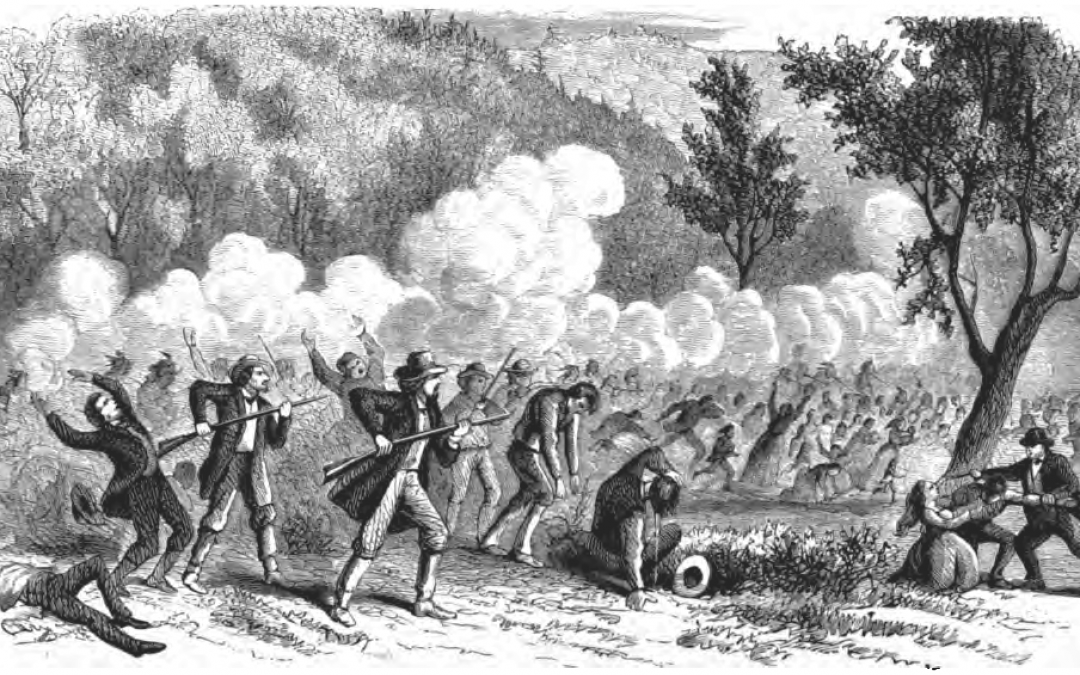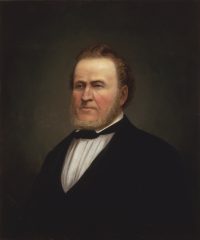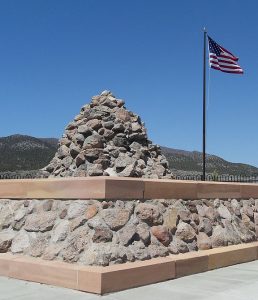The Church of Jesus Christ of Latter-day Saints was restored from Jesus Christ’s ancient Church in 1830. Since that time, there have been some black marks on the Church’s history. One of the most controversial and highly debated events is the Mountain Meadows Massacre.
Basic Timeline Of The Mountain Meadows Massacre
The Mountain Meadows Massacre took place over the course of five days. The first attack was on September 7, 1857. The final attack was on September 11, 1857.
September 7, 1857
John D. Lee, a member of the Church, and a militia major whose jurisdiction was over the Fort Harmony area in Southern Utah led an attack against the emigrant camp. Lee had recruited some Paiute Indians and had planned on fooling the emigrants into thinking they were only being attacked by the Paiutes. The emigrants fought back, and although several of them perished, they were able to force Lee to retreat. The emigrants then constructed a defensive hold with their wagons.
At some point after this first attack, Cedar City militiamen attacked two emigrants who were outside of the defensive hold. One of the emigrants died, however, the other managed to escape back to the other emigrants. He was able to inform the other emigrants that militiamen, not Paiutes, had attacked him and his companion.
September 8-9, 1857
During the course of these two days, there were two other attacks against the emigrants.
On September 9th, Isaac Haight, who was a stake president in the Church, Cedar City mayor, and a militia major, set up a meeting to speak with William Dame, the district militia commander over Cedar City, and another stake president himself. After speaking to Dame privately, Haight felt as though he had obtained permission to call out the militia for further attacks.
September 11, 1857

White Flag via markstarlite on flickr.com cc
Lee approached the emigrant defensive hold with a white flag. His terms were that the militia would safely escort the emigrants back to Cedar City, however, the emigrants had to leave behind all their belongings, including their weapons.
The youngest emigrant children were put into a wagon, which was at the front of the line to be led back to Cedar City. A wagon with the injured emigrants followed. The emigrant women and children walked after the two wagons, and the emigrant men walked after the woman. Each emigrant man had an armed militiaman with him.
After a little ways, hiding Paiute Indians attacked. The Paiutes and the militiamen killed the all the emigrant men, women, older children, and wounded emigrants.
This massacre resulted in about 120 emigrant deaths and 17 orphaned children.
Events Leading Up To The Mountain Meadows Massacre
To better understand the events of the Mountain Meadows Massacre, some other variables need to be addressed.
Threats Of An Army
The Mormon settlers had been informed before the emigrants had arrived that an army of 1,500 troops was headed their way, to either drive them out of their homes or kill them. If that wasn’t worrisome enough, there was word of even more enforcements being sent to follow. This threat was part of a larger-scale event that was happening at the time, known as the Utah War. Because of this threat, the Mormon settlers were very on edge.
Instructions From Church Leaders
In reaction to the threat of the approaching army, Brigham Young declared Utah to be in a state of martial law. Young instructed the Church leaders that they needed to save all their supplies, especially food, in the event that they would quickly need to flee their homes. The settlers were instructed to expect and prepare for an aggressive military attack.
However, Cedar City was the last place the emigrants could resupply before entering California. But many of the supplies they needed just weren’t even being offered, or the price was simply outrageous. This greatly added to the tension between the two groups.
Suspicion Of Poisoning
Naturally, some of the cattle that the emigrants brought with them died. These cattle may have died from multiple causes, however, one cause was disease picked up during their travels. Humans would then eat the contaminated meat and would become infected themselves.
Today, we have the scientific understanding of disease and bacteria to realize what was happening. But, back in the 1850s, the emigrants didn’t understand what was going on. They believed that the cattle, and those who ate the contaminated cattle, were being poisoned. As you can imagine, this escalated the tension between the two groups.
Heated Threats
After the emigrants had been refused supplies to trade, the emigrants were understandably very upset. After a lot of frustration, offensive statements and threats were made, most likely on both sides.
It has been documented that an emigrant man stated to the Mormon settlers that he had in his possession one of the guns that had killed Joseph Smith. Some of the emigrants made threats to join in with the army that was rumored to be coming, while others said they were going to make trouble for the settlers once they got to California.
We can probably guess that most if not all the threats and statements made were untrue, or just made in anger in an effort to scare and hurt each other. But for the leaders of the Mormon settlers, the threats felt very real.
Past Religious Persecution
Lastly, past religious persecution of the Mormons created enormous tension between the emigrants and the Latter-day Saint settlers.
The emigrant party was made up of people from Missouri and Arkansas. This alone was enough to create tension because the people of Missouri had driven the Mormons out of the state, at great loss to the Mormon people.
Then, in May, only a few months prior to the massacre, Parley P. Pratt, one of the Twelve Apostles of the Church, was murdered in Arkansas by an Arkansas man.
Brigham Young Involvement
There is a lot of debate on whether or not Brigham Young was involved in the massacre, and if so, how much. Richard E. Turley, who has studied the massacre in great detail, has given us insight into this matter.
On September 6th, 1857, one day before the first attack, Isaac Haight sent an express delivery message to Brigham Young in Salt Lake City, Utah. This message explained what was happening, and asked for advice on what to do. The next day, just before Haight sent off the letter, John Lee prematurely attacked the emigrant camp while they were at the Mountain Meadows. This went against the initial plan to wait to attack the emigrants in the Santa Clara Canyon. Unfortunately, the letter sent to Young did not contain news of this attack.
Young’s express reply (all messages were carried 250 miles on horseback) arrived September 13th, 1857. It was dated September 10th. Young sent word that the army would not be able to make it to the Utah territory before the winter months, and that “the Lord has answered our prayers and again averted the blow designed for our heads.” He then advised that the settlers were to leave the emigrants alone, and to “not meddle with them.” The settlers “should try and preserve good feelings with them.”
Actions Of The Individuals
The events of the Mountain Meadows Massacre were absolutely appalling. However, it’s important to remember that these actions were choices made by individuals acting in ways that are very contradictory to the teachings of the Church. As soon as Church leaders were made aware of the truth of what happened, they took action against those involved. Turley had this to say about the delay in a penalty:
Although Brigham Young and other Church leaders in Salt Lake City learned of the massacre soon after it happened, their understanding of the extent of the settlers’ involvement and the terrible details of the crime came incrementally over time.
Isaac Haight, and John D. Lee, who were some of the main instigators, were both eventually excommunicated from the Church. Several people who were involved were indicted and arrested. Lee was the only person tried, and he was found guilty. Lee was eventually executed for his actions. Others spent the rest of their lives running from the law.
Making Amends
The horror and devastation of what happened cannot ever be forgotten. But in an effort to help emotionally support relatives of the emigrants, the Church has helped construct two memorials in honor of the victims.
On the 150th anniversary, Henry B. Eyring, a member of the Quorum of the Twelve Apostles, delivered an address during the memorial service at the site. In his address, he talked about how horrible and inexcusable the events of the Mountain Meadows Massacre was.
Eyring also expressed how remorseful leaders of the Church are for the events that took place, and for all the suffering experienced by the victims, relatives of the victims, and the Paiute people, who were unjustly blamed.
Eyring ensured that “Divine Justice will impose appropriate punishment upon those responsible for the massacre.”
He concluded his remarks with expressing love towards those who have been affected and a desire for reconciliation.
Words From Mormon Descendents Of The Victims
James Sanders–great-grandson of Nancy Saphrona Huff, a child survivor, said:
I still feel pain; I still feel anger and sadness that the massacre happened …But I know that the people who did this will be accountable before the Lord, and that brings me peace. [This] didn’t affect my faith because it’s based on Jesus Christ, not on any person in the Church.
Sharon Chambers–great-granddaughter of Rebecca Dunlap, a child survivor, said:
The people who did this had lost their way. I don’t know what was in their minds or in their hearts … I feel sorrow that this happened to my ancestors. I also feel sorrow that people have blamed the acts of some on an entire group, or on an entire religion.
The information used in this article was gathered largely from an article published in the Ensign, a magazine published by The Church of Jesus Christ of Latter-day Saints, in 2007. The article is titled, ‘The Mountain Meadows Massacre’, and is written by Richard E. Turley. Turley was, at the time of his article being published, the managing director of the Church’s Family and Church History Department. Currently, he is the managing director of the Church’s Public Affairs Department.
Turley has spent many years studying the Mountain Meadows Massacre; he has co-authored a book on the subject titled, ‘Massacre at Mountain Meadows’, which is labeled on Amazon as “the most thoroughly researched account of the massacre ever written.”




